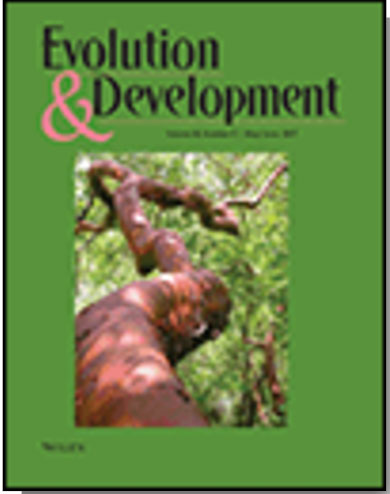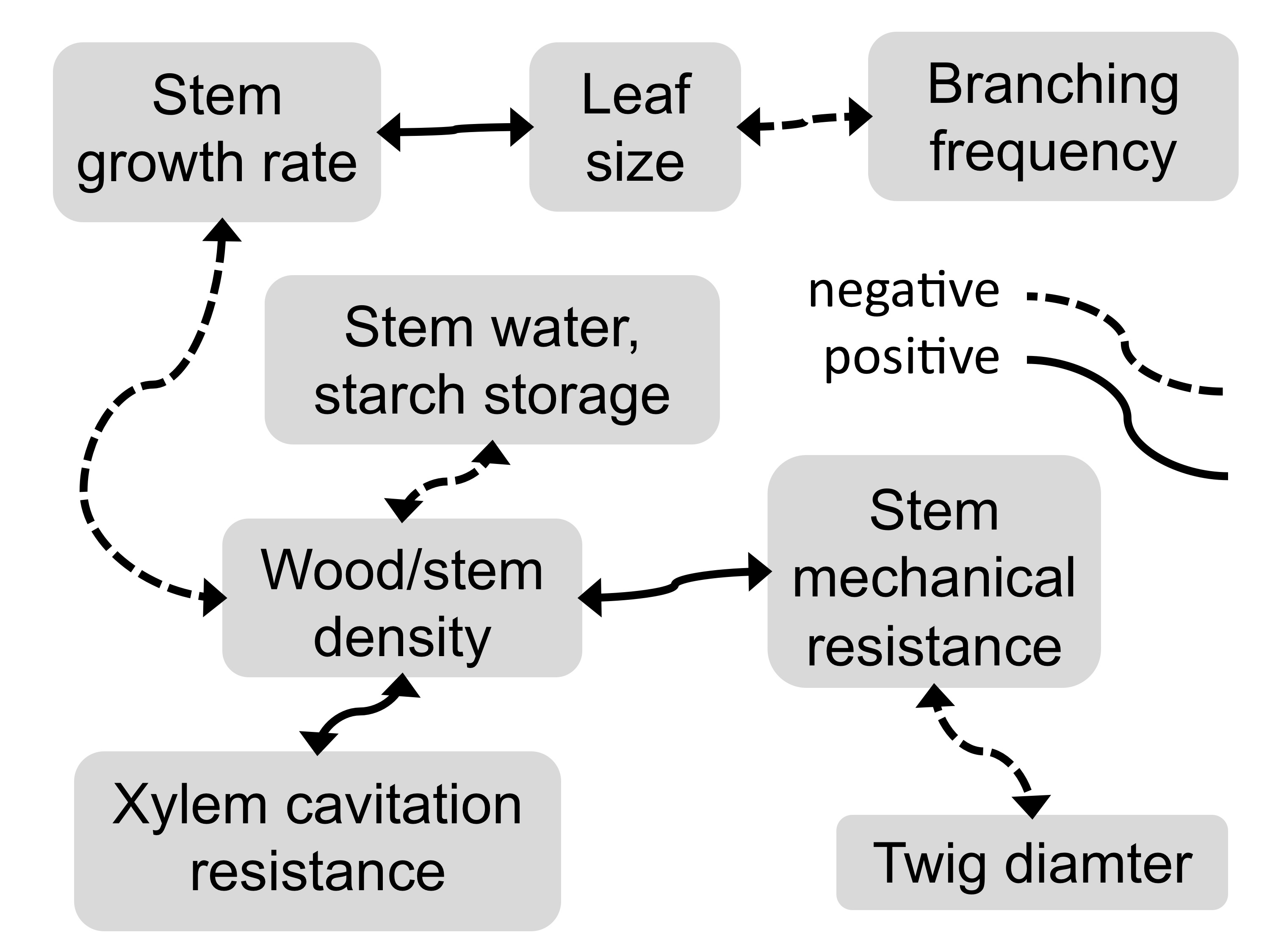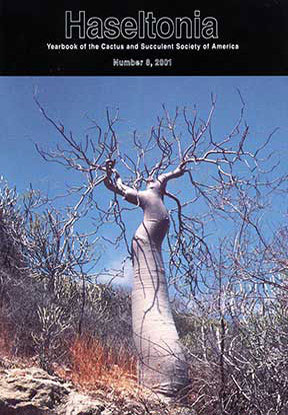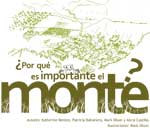
Current lab residents • Alumni • Facilities • Field trips
publications are organized in four categories:
· Evolutionary Theory
· Plant systematics and evolution
· Evolution and applied research in Moringa
· Conservation and outreach
| Evolutionary Theory Olson, M. E. 2019. Spandrels and trait delimitation: no such thing as “architectural constraint.” Evolution and Development 21: 59-71. pdf Olson, M. E., A. Arroyo-Santos, F. Vergara-Silva. 2019. A user’s guide to metaphors in ecology and evolution. Trends in Ecology and Evolution 34: 605-615 pdf Olson, M. E. 2019. Overcoming the constraint-adaptation dichotomy: Long live the adaptation-constraint dichotomy. Pp. 123-139 en Fusco. G., ed. Perspectives on Evolutionary and Developmental Biology. University of Padova Press. pdf (whole book, 14.7 Mb) Olson, M. E., and A. Arroyo-Santos. 2015. How to study adaptation (and why to do it that way). Quarterly Review of Biology 90: 167-191. pdf Arroyo-Santos, A., M. E. Olson, and F. Vergara-Silva. 2015. Practice-oriented controversies and borrowed epistemic credibility in current evolutionary biology: phylogeography as a case study. Perspectives on Science 23: 310-334. pdf Arroyo-Santos, A., M. E. Olson, and F. Vergara-Silva. 2014. The phylogeography debate and the epistemology of model-based evolutionary biology. Biology and Philosophy 29: 833-850. pdf Olson, M. E. 2014. The pleasures of theory in developmental biology [review of Minelli A and T Pradeu, eds. 2014. Towards a Theory of Development, Oxford]. Evolution & Development 16: 394-396. pdf Olson, M. E. 2012. The developmental renaissance in adaptationism. Trends in Ecology & Evolution 27(5): 278–287. pdf Olson, M. E. and A. Arroyo-Santos. 2009. Thinking in continua: beyond the "adaptive radiation" metaphor. BioEssays 31 (12): 1337 - 1346. article pdf • highlights from this issue • supplementary Fig. 1 • supplementary Tab. 1 • supplementary Tab. 2 Plant Morphological Evolution and Systematics Trejo, L., Briones-Dumas, E., Gómez-Bermejo, R. and Olson, M.E., 2019. Molecular evidence for repeated recruitment of wild Christmas poinsettia (Euphorbia pulcherrima) into traditional horticulture in Mexico. Genetic Resources and Crop Evolution 66: 481-490. pdf Echeverría, A., T. Anfodillo, D. Soriano, J. A. Rosell, and M. E. Olson. 2019. Constant theoretical conductance, changes in vessel diameter and number with height growth in Moringa oleifera. Journal of Experimental Botany. https://doi.org/10.1093/jxb/erz329 pdf Olson, M. E. 2019. Plant evolutionary ecology in the age of the extended evolutionary synthesis. Integrative and Comparative Biology doi.org/10.1093/icb/icz042 pdf Olson, M. E., J, Pittermann. 2019. Cheap and attractive: water relations and floral adaptation. New Phytologist. doi.org/10.1111/nph.15839 pdf Fajardo, A., E. McIntire, M. E. Olson, M.E. 2019. When short stature is an asset in trees. Trends in Ecology and Evolution 34: 193-199. Pittermann, J. y M. E. Olson. 2018. Transport efficiency and cavitation resistance in developing shoots: a risk worth taking. Tree Physiology 38: 1085–1087. Olson, M. E., D. Soriano, J. A. Rosell, T. Anfodillo, M. J. Donoghue, E. J. Edwards, C. León-Gómez, T. Dawson, J. J. Camarero Martínez, M. Castorena, A. Echeverría, C. I. Espinosa, A. Fajardo, A. Gazol, S. Isnard, R. S. Lima, C. R. Marcati, and R. Méndez-Alonzo. 2018. Plant height and hydraulic vulnerability to drought and cold. PNAS doi 10.1073/pnas.1721728115 article pdf supporting information dataset Olson, M.E., Rosell, J.A., Muñoz, S. and Castorena, M., 2018. Carbon limitation, stem growth rate and the biomechanical cause of Corner’s rules. Annals of botany. doi.org/10.1093/aob/mcy089. pdf Trejo, L, J. A. Rosell, and M E. Olson. 2018. Nearly 200 years of sustained selection have not overcome the leaf area–stem size relationship in the poinsettia. Evolutionary Applications doi.org/10.1111/eva.12634. pdf Rosell, J.A., Olson, M.E., Anfodillo, T. and Martínez‐Méndez, N., 2017. Exploring the bark thickness–stem diameter relationship: clues from lianas, successive cambia, monocots and gymnosperms. New Phytologist, 215(2), pp.569-581. pdf  Montes‐Cartas, C. G., Padilla,
P., Rosell, J.A., Domínguez, C.A., Fornoni, J. and Olson, M.E., 2017.
Testing the hypothesis that biological modularity is shaped by
adaptation: Xylem in the Bursera simaruba clade of tropical trees.
Evolution & Development, 19(3), pp.111-123. pdf Montes‐Cartas, C. G., Padilla,
P., Rosell, J.A., Domínguez, C.A., Fornoni, J. and Olson, M.E., 2017.
Testing the hypothesis that biological modularity is shaped by
adaptation: Xylem in the Bursera simaruba clade of tropical trees.
Evolution & Development, 19(3), pp.111-123. pdfRosell, J.A., Olson, M.E., and T. A. Anfodillo, T., 2017. Scaling of Xylem Vessel Diameter with Plant Size: Causes, Predictions, and Outstanding Questions. Current Forestry Reports, pp.1-14. pdf Trueba, S., Pouteau, R., Lens, F., Feild, T.S., Isnard, S., Olson, M.E. and Delzon, S., 2017. Vulnerability to xylem embolism as a major correlate of the environmental distribution of rain forest species on a tropical island. Plant, Cell & Environment, 40(2), pp.277-289. Trueba, S., Isnard, S., Barthélémy, D. and Olson, M.E. 2016. Trait coordination, mechanical behaviour and growth form plasticity of Amborella trichopoda under variation in canopy openness. AoB Plants, 8, p.plw068. pdf Anfodillo, T., Petit, G., Sterck, F., Lechthaler, S. and Olson, M.E., 2016. Allometric Trajectories and “Stress”: A Quantitative Approach. Frontiers in Plant Science, 7. pdf Castorena, M., J. A. Rosell, and M. E. Olson. 2015. Trubs, but no trianas: filled and empty regions of angiosperm stem length-diameter-mechanics space. Botanical Journal of the Linnean Society 179: 361–373. pdf Cervantes-Alcayde, M. A., M. E. Olson, K. M. Olsen, and L. E. Eguiarte. 2015. Apparent similarity, underlying homoplasy: Morphology and molecular phylogeny of the North American clade of Manihot. American Journal of Botany 102:520-532. pdf Ewers, F. W., J. A. Rosell, and M. E. Olson. 2015. Lianas, structural parasites. Pp. 163-188 in Hacke, U., ed. Functional and Ecological Xylem Anatomy. Springer. pdf Rojas-Piña, V., M. E. Olson, L. O. Alvarado-Cárdenas, and L. E. Eguiarte. 2014. Molecular phylogenetics and morphology of Beaucarnea (Ruscaceae) as distinct from Nolina, and the submersion of Calibanus into Beaucarnea. Taxon 63: 1193-1211. article pdf supplementary files Rosell, J. A, and M. E. Olson. 2014. Do lianas really have wide vessels? Vessel diameter-stem length scaling in non self-supporting plants. Perspectives in Plant Ecology, Evolution, and Systematics 16: 288-295. article pdf Appendix A (data) Olson, M. E., T. Anfodillo, J. A. Rosell, G. Petit, A. Crivellaro, S. Isnard, C. León-Gómez, L. O. Alvarado-Cárdenas, and M. Castorena. 2014. Universal hydraulics of the flowering plants: vessel diameter scales with stem length across angiosperm lineages, habits and climates. Ecology Letters 17: 988-997. article pdf Appendix S1 (data) Appendix S2 (phylogeny) Fig. S1 (optimality prediction) Table S1 (vessel density models) Table S2 (envtal indices) Olson, M. E. 2014. Xylem hydraulic evolution, I. W. Bailey, and Nardini & Jansen (2013): pattern and process. New Phytologist 203: 7-11. pdf Rosell, J. A., and M.E. Olson. 2014. The evolution of bark mechanics and storage across habitats in a clade of tropical trees. American Journal of Botany 101: 764-777. pdf Carlquist, S., B. F. Hansen, H. H. Iltis, M. E. Olson, and D. L. Geiger. 2014. Forchhammeria and Stixis (Brassicales): stem and wood anatomical diversity, ecological and phylogenetic significance. Aliso 31: 59-75. pdf Olson, M. E., J. A. Rosell, C. León, S. Zamora, A. Weeks, L. O. Alvarado-Cárdenas, N. I. Cacho, and J. Grant. 2013. Convergent vessel diameter-stem diameter scaling across five clades of New- and Old- World eudicots from desert to rain forest. International Journal of Plant Sciences 174(7):1062–1078. pdf Olson, M. E. and J. A. Rosell. 2013. Vessel diameter–stem diameter scaling across woody angiosperms and the ecological causes of xylem vessel diameter variation. New Phytologist 197: 1204–1213. pdf Alvarado-Cárdenas, L.O., Martínez-Meyer E., Feria T.P., Eguiarte L.E., Hernández H.M., Midgley G., and Olson M.E. 2013. To converge or not to converge in environmental space: testing for similar environments between analogous succulent plants of North America and Africa. Annals of Botany 111:1125-38. pdf Méndez-Alonzo, R., F. Pineda-García, H. Paz, J. A. Rosell, and M. E. Olson. 2013. Leaf phenology is associated with soil water availability and xylem traits in a tropical dry forest. Trees 27:745–754. pdf Méndez-Alonzo, R., H. Paz, J. A. Rosell, and M. E. Olson. 2012. Coordinated evolution of leaf and stem economics in tropical dry forest trees. Ecology 93: 2397–2406. pdf Rosell, J. A., M. E. Olson, R. Aguirre-Hernández, and F. J. Sánchez-Sesma. 2012. Ontogenetic modulation of branch size, shape, and biomechanics produces diversity across habitats in the Bursera simaruba clade of tropical trees. Evolution & Development 14: 437–449. pdf Trejo, L., M. E. Olson, P. Feria, K. M. Olsen, L. E. Eguiarte, B. Arroyo y J. A. Gruhn. 2012. Poinsettia’s wild ancestor in the Mexican dry tropics: historical, genetic, and environmental evidence. American Journal of Botany 99: 1146–1157. pdf Olson, M. E. 2012. Linear trends in botanical systematics and the Major Trends of Xylem Evolution. Botanical Review. 78: 154-183. pdf De-Nova, J. A., R. Medina, J. C. Montero, A. Weeks, J. A. Rosell, M. E. Olson, L. E. Eguiarte, and S. Magallón. 2012. Insights into the historical construction of species-rich Mesoamerican seasonally dry tropical forests: the diversification of Bursera (Burseraceae, Sapindales). New Phytologist 193(1): 276–287. pdf Gernandt, D. S., C. León-Gómez, S. Hernández-León, and M. E. Olson. 2011. Pinus nelsonii and a cladistic analysis of Pinaceae ovulate cone characters. Systematic Botany 36(3): 583-594. pdf Rosell, J. A., M. E. Olson, A. Weeks, J. A. De-Nova, R. Medina Lemos, J. Pérez Camacho, T. P. Feria, R. Gómez-Bermejo, J. C. Montero, and L. E. Eguiarte. 2010. Diversification in species complexes: Tests of species origin and delimitation in the Bursera simaruba clade of tropical trees (Burseraceae). Molecular Phylogenetics and Evolution 57: 798–811. pdf Cacho, N. I., P. E. Berry, M. E. Olson, V. W. Steinmann, and D. A. Baum. 2010. Are spurred cyathia a key innovation? Molecular systematics and trait evolution in the slipper-spurges (Pedilanthus clade - Euphorbia, Euphorbiaceae). American Journal of Botany 97(3): 493-510. pdf   Olson,
M. E., R.
Aguirre-Hernández, and J. A. Rosell. 2009. Universal
crown-stem scaling in dicot trees: plasticity, biomechanics, and
Corner's Rules. Ecology Letters
12(3):
210-219. article
pdf
• dataset
• dataset
header key
• R
code for fitting
multiple mixed model and per-species models • comparisons
between multiple models and per-species models Olson,
M. E., R.
Aguirre-Hernández, and J. A. Rosell. 2009. Universal
crown-stem scaling in dicot trees: plasticity, biomechanics, and
Corner's Rules. Ecology Letters
12(3):
210-219. article
pdf
• dataset
• dataset
header key
• R
code for fitting
multiple mixed model and per-species models • comparisons
between multiple models and per-species modelsRosell, J. A. and M. E. Olson. 2007. Testing implicit assumptions regarding the age vs. size dependence of stem biomechanics using Pittocaulon (~Senecio) praecox (Asteraceae). American Journal of Botany 94(2): 161-172. pdf Rosell J. A., M. E. Olson, R. Aguirre Hernandez, and S. Carlquist. 2007. Logistic regression in comparative wood anatomy: tracheid types, wood anatomical terminology, and new inferences from the Carlquist and Hoekman southern Californian data set. Botanical Journal of the Linnean Society 154(3): 331-351. pdf Olson, M. E. 2005. Typology, homology, and homoplasy in comparative wood anatomy. International Association of Wood Anatomists Journal 26 (4): 507-523. pdf Olson, M. E. 2005. Wood, bark, and pith anatomy in Pittocaulon (Senecio, Asteraceae): water storage and systematics. Journal of the Torrey Botanical Society 132(2): 173-186. pdf Olson, M. E. 2003. Stem and leaf anatomy of the arborescent Cucurbitaceae Dendrosicyos socotrana, with comments on the evolution of pachycauls from lianas. Plant Systematics and Evolution 239 (3 and 4): 199-214. pdf Olson, M. E., Gaskin, J.F., Ghahremani-nejad, F. 2003. Wood anatomy is congruent with molecular phylogenies placing Hypericopsis persica in Frankenia (Frankeniaceae); comments on vasicentric tracheids. Taxon 52(3): 525-532. pdf Berry, P., and M. E. Olson. 1998. Eucaerea rhaeophytica, a new rheophyte from the Guayana region of Venezuela. Brittonia 50: 493-496. pdf Olson, M. E., P. Berry, and G. Aymard. 1998. Flacourtiaceae. in Steyermark, J. A., P. E. Berry, and B. K. Holst, eds. Flora of the Venezuelan Guayana vol. 5. Timber Press, Portland. Evolution and Applied Research in Moringa Fahey, J., K. Wade, K. Stephenson, Y. Shi, H. Liu, A. Panjwani, C. Warrick, M. E. Olson. 2019. A strategy to deliver precise oral doses of the glucosinolates or isothiocyanates from Moringa oleifera leaves for use in clinical studies. Nutrients 11. doi:10.3390/nu11071547. pdf Nouman, W., Olson, M.E., Gull, T., Zubair, M., Basra, S.M.A., Qureshi, M.K., Sultan, M.T. y Shaheen, M., 2018. Drought affects size, nutritional quality, antioxidant activities and phenolic acids pattern of Moringa oleifera Lam. Journal of Applied Botany and Food Quality 91: 79-87. Fahey JW, ME Olson, KK Stephenson, KL Wade, GM Chodur, D Odee. 2018. The Diversity of Chemoprotective Glucosinolates in Moringaceae (Moringa spp.) Scientific Reports 8 (1), 7994. pdf Chodur GM, ME Olson, KL Wade, KK Stephenson, W Nouman, JW Fahey. 2018. Wild and domesticated Moringa oleifera differ in taste, glucosinolate composition, and antioxidant potential, but not myrosinase activity or protein content. Scientific Reports 8 (1), 7995. pdf Olson, M. E. 2017. Moringa frequently asked questions. Acta Horticulturae 1158. ISHS 2017. DOI 10.17660/ActaHortic.2017.1158.4 pdf Olson, M. E. y L. O. Alvarado-Cárdenas. 2016. ¿Dónde cultivar el árbol milagro, Moringa oleifera, en México? Un análisis de su distribución potencial (Where to grow the miracle tree, Moringa oleifera, in Mexico? An analysis of its potential distribution). Revista Mexicana de Biodiversidad 87: 1089-1102. In Spanish with English abstract. pdf Olson, M. E., Sankaran, R. P., Fahey, J. W., Grusak, M. A, Odee, D., Nouman, W. 2016. Leaf protein and mineral concentrations across the “miracle tree” genus Moringa. PLoS ONE 11(7): e0159782. doi:10.1371/journal.pone.0159782. pdf Olson, M. E. and J. W. Fahey. 2011. Moringa oleifera: un árbol multiusos para las zonas tropicales secas (Moringa oleifera: a multipurpose tree for the dry tropics). Revista Mexicana de Biodiversidad 82(4): 1071-1082. pdf Olson, M. E. 2010. Moringaceae: Drumstick Family. Pp. 167-169 in Flora of North America Editorial Committee, eds. 1993+. Flora of North America North of Mexico. 15+ vols. New York and Oxford. Vol. 7. pdf Olson, M. E. 2007. Wood ontogeny as a model for studying heterochrony, with an example of paedomorphosis in Moringa (Moringaceae). Systematics and Biodiversity 5(2): 145–158. pdf Olson, M. E. and J. Rosell. 2006. Using heterochrony to infer modularity in the evolution of stem diversity in Moringa (Moringaceae). Evolution 60 (4): 724–734. pdf Olson, M. 2003. Developmental origins of floral bilateral symmetry in Moringaceae. American Journal of Botany 90(1): 49-71. pdf App. 1 Olson, M. E. 2002. Intergeneric relationships within the Caricaceae-Moringacecae clade (Brassicales), and potential morphological synapomorphies of the clade and its families. International Journal of Plant Sciences 163(1):51-65. pdf Olson, M. E. 2002. Combining data from DNA sequences and morphology for a phylogeny of Moringaceae. Systematic Botany 27(1): 55-73. pdf Olson, M. E., and S. Carlquist. 2001. Stem and root anatomical correlations with life form diversity, ecology, and systematics in Moringa (Moringaceae). Botanical Journal of the Linnean Society 135(4): 315-348. pdf  Olson, M. 2001. Stem and root anatomy of Moringa (Moringaceae). Haseltonia 8: 56-96. Lianli, L., and M. E. Olson. 2001. Moringaceae. in Raven, P. H., I. Al-Shehbaz, and G. Zhu, eds. Flora of China vol. 8: 196. Missouri Botanical Garden Press. Olson, M. E., and S. G. Razafimandimbison. 2000. Moringa hildebrandtii: A tree extinct in the wild but preserved by indigenous horticultural practices in Madagascar. Adansonia sér. 3 22(2) 217-221. pdf Outreach, conservation, and exploration Trejo, L. and M.E. Olson. 2016. Diversidad genética y relaciones de parentesco de nochebuenas (Euphorbia pulcherrima) sembradas en parques y jardines (Genetic diversity and relationships of poinsettia in parks and gardens) En: La biodiversidad en la Ciudad de México, vol. ii. conabio/sedema, México, pp. 490-493. pdf. Trejo-Hernández, L., M. E. Olson, and R. A. Bye. 2015. Datos históricos y diversidad genética de las nochebuenas (Euphorbia pulcherrima) del Distrito Federal, México (Historical data and genetic diversity of poinsettia (Euphorbia pulcherrima) in the Distrito Federal, Mexico). Revista Mexicana de Biodiversidad 86: 478–485. (in Spanish with English abstract), pdf.  Renton, K., P. Balvanera, M. E. Olson and A. Castillo (illustrations Mark Olson). 2012. ¿Por qué es importante el monte? UNAM Press ISBN 978-607-02-3733-1 (public outreach book on the importance of the dry tropical forest of the Mexican Pacific) pdf Feria A., T. P, M. E. Olson, A. García-Mendoza, and E. Solano. 2009. A GIS-based comparison of the Mexican national and IUCN criteria for determining extinction risk. Conservation Biology 23: 1156-1166. pdf Olson, M. E. 2006. Powered paragliders in biodiversity exploration. Revista Mexicana de Biodiversidad 77: 297-305. pdf Olson, M. E., J. A. Lomelí S. and N. Ivalú Cacho. 2005. Extinction threat in the Pedilanthus clade (Euphorbia, Euphorbiaceae), with special reference to the recently-rediscovered E. conzattii (P. pulchellus). American Journal of Botany 92 (4): 634-641. article pdf supplement 1 supplement 2 supplement 3 |
home - research - images of the dry tropics - plant pages - exploration - acknowledgements
Instituto de Biología,
Universidad Nacional Autónoma de México
Circuito Exterior s/n, Ciudad Universitaria
Copilco, Coyoacán A. P. 70-367
C. P. 04510, México, D. F.
MÉXICO
(52) 55 5622-9124 fon (52) 55
5555-1760 fax
molson@ib.unam.mx
all material © 2014
Mark E Olson